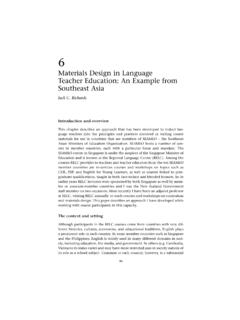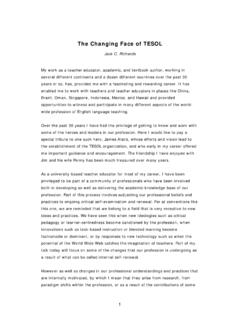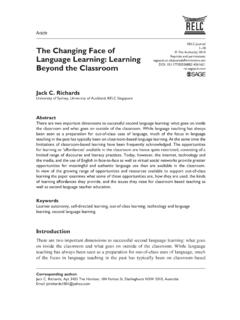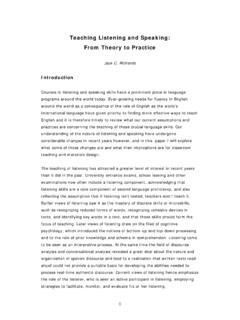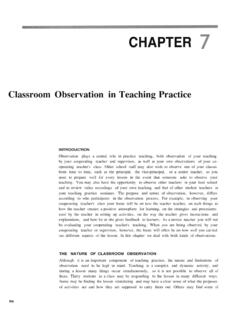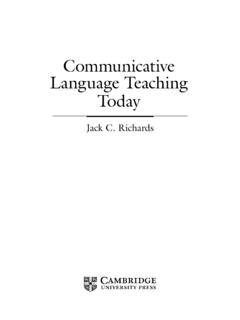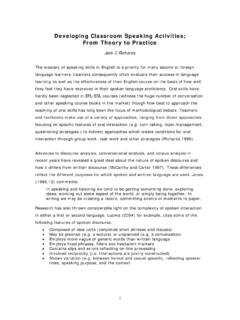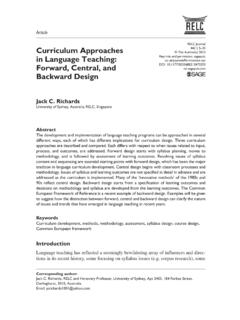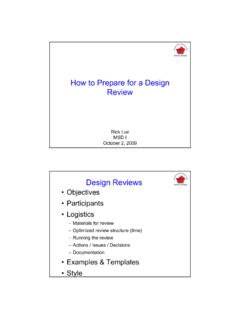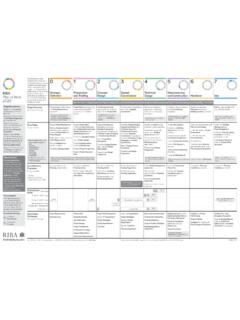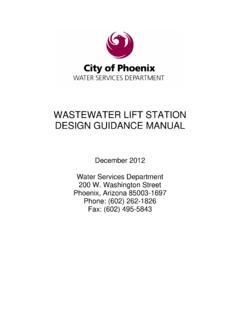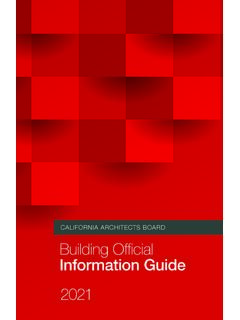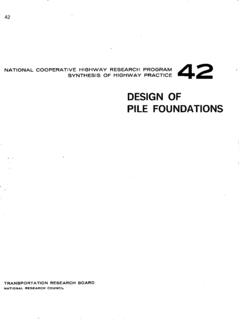Transcription of 6 The structure of a language lesson
1 6 ThestructureofalanguagelessonLessons are events which are fairly easy to recognize. They take place ina particular setting ( , a school or classroom), they normally involvetwo kinds of participants (the teacher and students), and they normallyconsist of recognizable kinds of activities ( , the teacher lecturing atthe front of the class, the teacher posing questions and calling on studentsto answer them). A lesson is, hence, distinguishable from other kinds ofspeech events, such as meetings, debates, arguments, or other speech events, however, lessons have a recognizable struc-ture. They begin in a particular way, they proceed through a series ofteaching and learning activities, and they reach a conclusion. This patternof structure or organization is a result of the teacher's attempts to managethe instructional process in a way which will optimize the amount oflearning that can take place in the time available.
2 Wong-Fillmore (1985:23-4)observes:How classes are organized and how instructional events are structureddetermine to a large extent the nature of the language that students hear anduse in the classroom .. Two sets of characteristics appear to distinguishclasses that work for language learning from those that do not. The first setrelates to the way the classes are structured or are organized for instruction,the second to the way language is used in on teaching in mainstream classes has found that when teachersstructure their lessons effectively, they:Begin a lesson with a short review of previous, prerequisite a lesson with a short statement of new material in small steps, with student practice after each clear and detailed instructions and a high level of active practice for all teaching in second language classroomsAsk a large number of questions, check for student understanding, and obtainresponses from all students during initial systematic feedback and explicit instruction and practice for seatwork exercises and, wherenecessary, monitor students during seatwork.
3 (Rosenshine and Stevens 1986: 377)This chapter concerns how lessons are organized into sequences and howthe momentum of a lesson is achieved. This is referred to focus will be on four dimensions of a lesson a lesson is divided into segments and how thesegments relate to each a sense of movement is achieved within a a lesson is brought to an opening of a lesson consists of the procedures the teacher uses tofocus the students' attention on the learning aims of the lesson . Researchon teaching suggests that the opening, or "entry," of a lesson generallyoccupies the first five minutes and can have an important influence onhow much students learn from a lesson (Kinds vatter, Wilen, and Ishler,1988). In her longitudinal study of limited English proficiency studentsin third and fifth grade classrooms in the United States, Wong-Fillmore(1985: 27) found that effective lessons for language learning wereformal, scheduled lessons with clear boundaries.
4 The beginnings of small-group lessons were usually marked by an actual change in the physicallocation of the students or by some other movement .. [such as] turningseats around so students face one another. The beginnings of such eventswere often marked by changes in the teacher's voice quality or volume, or inthe teacher's location or posture, these serving to call the group to beginnings can serve a variety of purposes. For example, specificlessons openings can be used to:Help learners to relate the content of the new lesson to that of the last orprevious lessons (cognitive contribution).Assess relevant knowledge (cognitive contribution).The structure ofalanguage lesson 115 Establish an appropriate "set" in learners: , prepare them for what is tofollow (cognitive or affective contribution).Allow "tuning-in" time - which may be especially important in situationswhere learners have come directly from a radically different environment(pragmatic contribution).
5 Reduce the disruption caused by late-arriving students (pragmaticcontribution).(McGrath, Davies, and Mulphin 1992:92-3)The way a lesson opens reflects a number of decisions that a teachermakes, either consciously or unconsciously. A number of options areavailable. For example, a teacher could choose to: describe the goals of a lesson . state the information or skills the students will learn. describe the relationship between the lesson /activities and a real-world need. describe what students are expected to do in the lesson . describe the relationship between the lesson /activities and a forth-coming test or exam. begin an activity without any explanation. point out links between this lesson and previous lessons. state that the activity the students will do is something they willenjoy. do something in order to capture the students' interest andmotivation.
6 review learning from a previous lesson . preview the a lesson beginning will determine the kind of activity orstrategy the teacher uses to begin the lesson (see Appendix1).Rosen-shine and Stevens (1986: 381) point out, for example, that beginning alesson with a short review provides additional opportunities to learnpreviously taught material and allows the teacher to provide correction orreteach areas that students are having difficulty with. This can be accom-plished by: Asking' questions about concepts or skills taught in the previouslesson. Giving a short quiz at the beginning of class on material from pre-vious lessons or homework assignments. Having students meet in small groups (two to four students pergroup) ~oreview Reflective teaching in second language classrooms Having students prepare questions about previous lessons or home-work.
7 They can ask questions to each other, or the teacher can askthem to the class. Having students prepare a written summary of the previous lesson . Having students ask the teacher about problems on homework andhaving the teacher review , re-teach, or provide additional their study of adult classes in EFL and modern languages, McGrath etal. (1992) found that lesson openings are used principally "to establish anappropriate affective framework for learning and, to a lesser extent, toestablish an appropriate cognitive framework" (p. 105). They also foundthat learners are sensitive to the contribution of lesson do these features of lessons affect language learning? Althoughthere is relatively little research on openings in second language class-rooms (however, see McGrath et al. 1992), Wong-Fillmore (1985) sug-gests that openings and other boundary markers within lessons, such astransitions and closings, help frame the event, giving students an idea ofwhat to expect and how to prepare for formulaic starters used by the teachers helped to signal when thesescheduled events were to begin, so the students knew when they should beginpaying attention and what they should be listening for.
8 (Wong-Fillmore1985: 28)The following lesson transcript shows how a teacher deals with a lessonopening in a language arts class for ESL students at secondary greeting the students (Ss) and dealing with noninstructional mat-ters, the teacher(T)begins:T: The other time we were talking about figures of speech. And wehave already in the past talked about three kinds of figures ofspeech. Does anybody remember those three types? Mary?S: Personification, simile, and : Good. Let me write those on the board. Now, can anybody tellme what personification is all about again? Juan?S: Making a non-living thing act like a : Yes. OK. Good enough. Now what about simile? .. OK,Cecilia?S: Comparing two things by making use of the words "like" or"as."T: OK. Good. I'll write that on the board. The other one -metaphor. Paul?The structure ofalanguage lesson 117S: It's when we make a comparison between two things, but wecompare them without using the words "like" or "as.
9 "T:All right. Good. So, it's more direct than a simile. Now, we hada poem a few weeks ago about personification. Do you remem-ber? Can you recall one line from that poem where a non-livingthing acts like a human person?S: "The moon walks the night."T: Good. 'The moon walks the night." Does the moon have feet towalk?Ss: :No. So this is a figure of speech. All right. Now, our lesson to-day has something to do with metaphor. We already did simileand we just slightly touched on metaphor before. Now we'regoing to see what they have in common. So, by the way, do youhave your songs with you?Ss: :Last week I told you we were going to share songs and thisweek it's my turn to share with you a song that I like. And 1have chosen a song by Simon and Garfunkel.(The class then listens to the song "I Am a Rock" and discusses themetaphors in the lyrics.)This teacher has chosen several strategies to begin her lesson .
10 She makeslinks to a previous lesson , she previews the current lesson , and she uses asong to capture the students' interest and provide further illustrations review the list of strategies for lesson openings on page strategies do you (or the teacher you are observing)use most frequently? Do you (or the teacher) use any strat-egies that are not on this list? For what purposes are thesestrategies used?2. Examine the list of purposes for lesson beginnings and the il-lustrative activities in Appendix 1. Can you add to the list ofpurposes? Choose one of the purposes on the list. Give otherexamples of activities that could be used to achieve You are teaching an intermediate reading class based on amagazine article about the dangers of boxing as a Reflective teaching in second language classroomsThink of a suitable opening for the lesson . Does it match one ofthe strategies listed on page 115?
